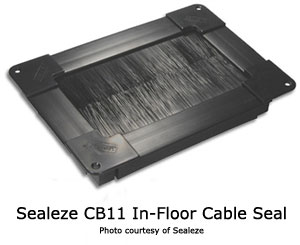Sealeze is a leading manufacturer of weather seal and industrial brush products. ProtoCAM has worked with Sealeze on multiple projects that span the product development cycle.
 Background
Background
In a project for one of the new Sealeze CoolBalance product lines, ProtoCAM was able to provide assistance with design for manufacturability (DFM) as a critical design factor that affected the production tooling after the prototyping for these plastic parts was completed.
The CoolBalance products are surface mounted cable seals used in computer rooms to keep the cool air in the room. The products have a rigid plastic circle, square or rectangle with flexible brush seals to block air flow in the open area when the cabling goes though a wall or floor passage.
Challenge
As with any design for manufacturability prototype project, several key questions needed to be answered.
- Moldable: Can the part be molded with conventional tooling?
- Tooling: Can the tooling be created at a reasonable cost to mold the part?
- Draft: Is the angle of the part designed so that it can easily release from the mold?
- Wall thickness: Will the wall thickness of part as designed provide the performance needed in use?
If the answer to any of these questions is “no,” at least some redesign is usually necessary.
Solution
Working together with ProtoCAM, Sealeze was able to help redesign a few plastic parts of these products at the prototype development phrase to make it easier and less expensive to manufacture later in large quantities. The benefits of implementing design for manufacturability are to increase profits while maintaining the functionality of the product.
In particular, for the CoolBalance CB11 In-Floor Cable Seal product, ProtoCAM plastic engineer Ed Graham helped revamp the design of corner part during development so that this plastic component would be able to be molded more easily in production using conventional tooling. During prototype development, the plastic part could have easily been made using stereolithography, but the original design would have been hard to mold. Graham’s expertise provided a few design for manufacturability changes — specifically changing its draft — that did not affect the product’s functionality, but made it easier to mold later in production.
Results
Graham’s suggestions were accepted by Sealeze’s product development team and incorporated into the final design.
“We had no prior experience with the injection mold process when we began working with ProtoCAM,” said Bruce Jaggard, Business Development Manager, Sealeze. “Besides our concerns about costs, quality, and delivery, we also feared making rookie mistakes with the technology.
“We needed and got the engineering help that assured us that we were in good hands. They assisted us in making revisions to the design to accommodate the injection mold process without compromising our product design criteria. The cost was competitive and they delivered on time. No need for us to look elsewhere in the future. They made me look good with my choice of vendors!”
